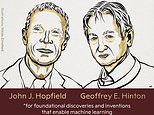
The 2024 Nobel Prize in Physics has been awarded to two scientists for developing the methods that are the foundations for today’s powerful AI.John Hopfield and Geoffrey Hinton received the prestigious award for ‘foundational discoveries and inventions that enable machine learning with artificial neural networks.’John Hopfield, of Princeton University, invented the methods which allow AI to save and recreate patterns.Geoffrey Hinton, of the University of Toronto, gave AI the ability to find properties in data allowing it to complete tasks like recognising elements in specific pictures.These discoveries allowed for the creation of the artificial neural networks which power modern chatbots such as ChatGPT. The 2024 Nobel Prize in Physics has been awarded to John Hopfield and Geoffrey Hinton for developing the methods that are the foundations for today’s powerful AI.Most modern artificial intelligences are based on a technology called artificial neural networks which mimic the connections between neurons in the brain.In the AI, the neurons are represented by nodes which influence each other through connections which can be made weaker or stronger – allowing AIs to learn over time.Without this technology, the powerful systems which run everything from ChatGPT to Apple Intelligence would not be possible.This year’s Nobel laureates were both instrumental in laying the foundations for these important advances from the 1980s onward,Ellen Moons, Chair of the Nobel Committee for Physics, says: ‘The laureates’ work has already been of the greatest benefit. ‘In physics we use artificial neural networks in a vast range of areas, such as developing new materials with specific properties.’John Hopfield was responsible for inventing a system called the ‘Hopfield Network’ which allows AI to save and recreate patterns. Today’s AIs use a system called Artifical Neural Networks which would not be possible without the work of Hopfield and Hinton With his background in physics, Hopfield attempted to understand how the individual neurons of the brain work together to create interesting new abilities.He imagined that the brain worked together like a network of nodes which were joined by connections of different strengths.Hopfield found that he could program these networks by feeding them an image and following a rule which adjusts the connections between the nodes to give the image ‘low energy’.You can think about this like shaping a landscape of peaks and troughs – when the network is fed an image it creates a valley in a virtual landscape where the bottom of the valley has the lowest energy.If you dropped a ball into this landscape it would keep rolling downwards towards lower energy until it was surrounded by uphills on all sides.In just the same way, the Hopfield network is able to find the closest matching pattern to a distorted or even partially deleted input. John Hopfield discovered a way of storing images in artificial networks which give computers the ability to find the closest matching saved image when provided with partially distorted data Geoffrey Hinton, meanwhile, recieved the Nobel Prize mainly for his work creating the ‘Boltzmann Machine’. These machines use the Hopfield network as their basis but give the network the new ability to recognise characteristic elements in a given type of data.Just like humans are able to recognise and interprate data according to catergories, Hinton wanted to know if the same would be possible for machines.To do this, Hinton and his collegaue Terrence Sejnowski, combined Hopfield’s energy landscapes with ideas taken from statistical physics.These methods allow scientists to describe systems that have too many individual parts to keep track of individually, such as the molecules which make up a cloud of gas. Even though we can’t keep track of all the parts, we can describe some states in which they could exist as more likely to occur and calculate these probabilities based on the amount of available energy. Geoffrey Hinton recieved the award for his work creating the Boltzmann Machine (illustrated) which expanded Hopfield networks to include ‘hidden’ layers which allow them to learn from examplesHinton’s breakthrough was to take an an equation by the nineteenth-century physicist Ludwig Boltzmann which describes this process and apply it to a Hopfield network. The resulting ‘Boltzmann machine’ has nodes like a Hopfield network but also contails a layer of ‘hidden’ nodes.The machine is run by updating the value the nodes one at a time until it finds a state where the pattern of the nodes can change without altering the proerties of the network as a whole.This allows the machine to learn by being given examples of what you are looking for.The machine can be trained by changing the values of its connections until the example pattern has the highest probability of appearing on the ‘visible nodes’. The advances created by Fieldman and Hinton have created the basis for the neural networks which power the most advanced moden AIThis allows the AI to recognise patterns in things it hasn’t seen before – just like how you can instantly tell a tiger is somehow related to your housecat even if you haven’t seen one before.By layering lots of these networks on top of eachother, we can create something which starts to resemble many of the AI’s we recognise today.For example a simple Boltzmann machine might be used to recommend you films based on what you had enjoyed before. Although the field of AI has come along way since Hopfield and Hinton made their initial discoveries, their work has laid the basis for some of the most important innovations in recent history.
Nobel Prize in Physics is awarded to two scientists for developing the methods that are the foundation of today’s most POWERFUL AI tools
Published on

